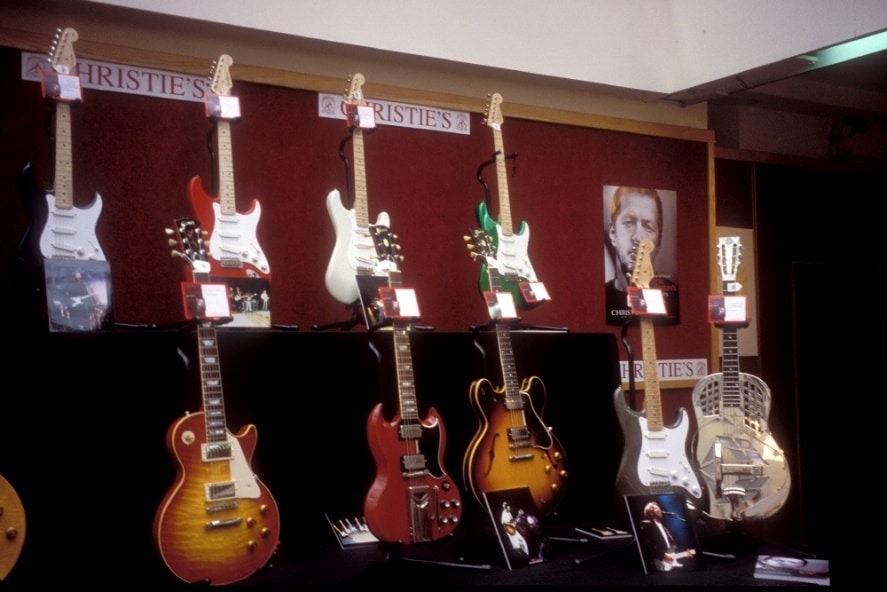Eric Clapton is an English rock and blues guitarist, singer, and songwriter. He is the only three-time inductee to the Rock and Roll Hall of Fame: once as a solo artist and separately as a member of the Yardbirds and of Cream. Clapton has been referred to as one of the most important and influential guitarists of all time. Clapton ranked second in Rolling Stone magazine’s list of the “100 Greatest Guitarists of All Time” and fourth in Gibson’s “Top 50 Guitarists of All Time”. He was also named number five in Time magazine’s list of “The 10 Best Electric Guitar Players” in 2009.
In the mid-1960s Clapton left the Yardbirds to play with John Mayall & the Bluesbreakers. Immediately after leaving Mayall, Clapton formed the power trio Cream with drummer Ginger Baker and bassist Jack Bruce, in which Clapton played sustained blues improvisations and “arty, blues-based psychedelic pop”. After Cream broke up, he formed blues rock band Blind Faith with Baker, Steve Winwood, and Ric Grech. Clapton’s solo career began in the 1970s, where his work bore the influence of the mellow style of J. J. Cale and the reggae of Bob Marley. His version of Marley’s “I Shot the Sheriff” helped reggae reach a mass market. Two of his most popular recordings were “Layla”, recorded with Derek and the Dominos; and Robert Johnson’s “Crossroads”, recorded with Cream. Following the death of his son Conor in 1991, Clapton’s grief was expressed in the song “Tears in Heaven”, which was featured on his Unplugged album.
Clapton has been the recipient of 18 Grammy Awards, and the Brit Award for Outstanding Contribution to Music. In 2004 he was awarded a CBE at Buckingham Palace for services to music. He has received four Ivor Novello Awards from the British Academy of Songwriters, Composers and Authors, including the Lifetime Achievement Award. In his solo career, Clapton has sold more than 130 million records worldwide. In 1998, Clapton, a recovering alcoholic and drug addict, founded the Crossroads Centre on Antigua, a medical facility for recovering substance abusers.
Early life
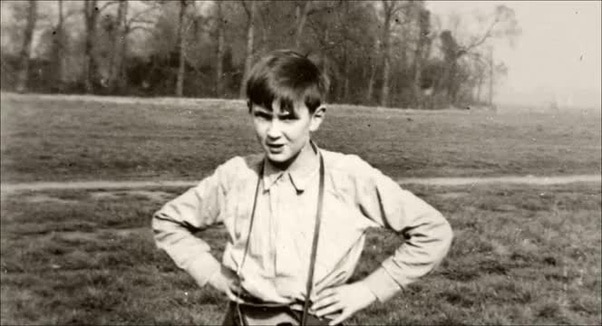
Clapton was born on 30 March 1945 in Ripley, Surrey, England, to 16-year-old Patricia Molly Clapton (7 January 1929 – March 1999) and Edward Walter Fryer (21 March 1920 – 15 May 1985), a 25-year-old soldier from Montreal, Quebec. Fryer shipped off to war prior to Clapton’s birth and then returned to Canada. Clapton grew up believing that his grandmother, Rose, and her second husband, Jack Clapp, Patricia’s stepfather, were his parents, and that his mother was his older sister. The similarity in surnames gave rise to the erroneous belief that Clapton’s real surname is Clapp. Years later, his mother married another Canadian soldier and moved to Germany, leaving young Eric with his grandparents in Surrey.
Clapton received an acoustic Hoyer guitar, made in Germany, for his thirteenth birthday, but the inexpensive steel-stringed instrument was difficult to play and he briefly lost interest. Two years later Clapton picked it up again and started playing consistently. Clapton was influenced by the blues from an early age, and practiced long hours to learn the chords of blues music by playing along to the records. He preserved his practice sessions using his portable Grundig reel-to-reel tape recorder, listening to them over and over until he felt he’d got it right.
In 1961, after leaving Hollyfield School in Surbiton, Clapton studied at the Kingston College of Art but was dismissed at the end of the academic year because his focus remained on music rather than art. His guitar playing was so advanced that, by the age of 16, he was getting noticed. Around this time, Clapton began busking around Kingston, Richmond, and the West End. In 1962, Clapton started performing as a duo with fellow blues enthusiast David Brock in pubs around Surrey. When he was seventeen years old, Clapton joined his first band, an early British R&B group, the Roosters, whose other guitarist was Tom McGuinness. He stayed with this band from January until August 1963. In October of that year, Clapton did a seven-gig stint with Casey Jones & the Engineers.
Early career, breakthrough, and international success
The Yardbirds and the Bluesbreakers
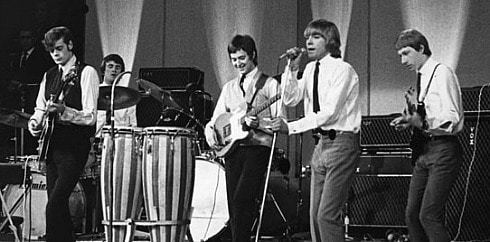
In October 1963, Clapton joined the Yardbirds, a blues-influenced rock and roll band, and stayed with them until March 1965. Synthesizing influences from Chicago blues and leading blues guitarists such as Buddy Guy, Freddie King, and B.B. King, Clapton forged a distinctive style and rapidly became one of the most talked-about guitarists in the British music scene. The band initially played Chess/Checker/Vee-Jay blues numbers and began to attract a large cult following when they took over the Rolling Stones’ residency at the Crawdaddy Club in Richmond. They toured England with American bluesman Sonny Boy Williamson II; a joint LP album, recorded in December 1963, was issued in 1965.
Yardbirds’ rhythm guitarist, Chris Dreja, recalled that whenever Clapton broke a guitar string during a concert, he would stay on stage and replace it. The English audiences would wait out the delay by doing what is called a “slow handclap”. Clapton’s nickname of “Slowhand” came from Giorgio Gomelsky, a pun on the slow handclapping that ensued when Clapton stopped playing while he replaced a string. In December 1964, Clapton made his first appearance at the Royal Albert Hall, London, with the Yardbirds. Since then, Clapton has performed at the Hall over 200 times, and has stated that performing at the venue is like “playing in my front room”.
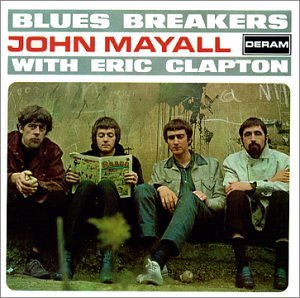 In March 1965, Clapton and the Yardbirds had their first major hit, “For Your Love”, written by songwriter Graham Gouldman, who also wrote hit songs for Herman’s Hermits and the Hollies (and would later achieve success of his own as a member of 10cc). In part because of its success, the Yardbirds elected to move toward a pop-oriented sound, much to the annoyance of Clapton, who was devoted to the blues and not commercial success. He left the Yardbirds on the day that “For Your Love” went public, a move that left the band without its lead guitarist and most accomplished member. Clapton suggested fellow guitarist Jimmy Page to be his replacement, but Page declined out of loyalty to Clapton, putting Jeff Beck forward. Beck and Page played together in the Yardbirds for a while, but Beck, Page, and Clapton were never in the group together. They first appeared together on the 12-date benefit tour for Action for Research into multiple sclerosis in 1983 with the first date taking place on 23 September at the Royal Albert Hall.
In March 1965, Clapton and the Yardbirds had their first major hit, “For Your Love”, written by songwriter Graham Gouldman, who also wrote hit songs for Herman’s Hermits and the Hollies (and would later achieve success of his own as a member of 10cc). In part because of its success, the Yardbirds elected to move toward a pop-oriented sound, much to the annoyance of Clapton, who was devoted to the blues and not commercial success. He left the Yardbirds on the day that “For Your Love” went public, a move that left the band without its lead guitarist and most accomplished member. Clapton suggested fellow guitarist Jimmy Page to be his replacement, but Page declined out of loyalty to Clapton, putting Jeff Beck forward. Beck and Page played together in the Yardbirds for a while, but Beck, Page, and Clapton were never in the group together. They first appeared together on the 12-date benefit tour for Action for Research into multiple sclerosis in 1983 with the first date taking place on 23 September at the Royal Albert Hall.
Clapton joined John Mayall & the Bluesbreakers in April 1965, only to quit a few months later. In June, Clapton was invited to jam with Jimmy Page, recording a number of tracks that would be retroactively credited to The Immediate All-Stars. In the summer of 1965 he left for Greece with a band called the Glands, which included his old friend Ben Palmer on piano. In November 1965 he rejoined John Mayall. In March 1966, while still a member of the Bluesbreakers, Clapton briefly collaborated on a side project with Jack Bruce and Steve Winwood among others, recording only a few tracks under the name Eric Clapton and the Powerhouse. During his second Bluesbreakers stint, Clapton gained a reputation as the best blues guitarist on the club circuit. Although Clapton gained world fame for his playing on the influential album, Blues Breakers – John Mayall – With Eric Clapton, this album was not released until he had left the band for the last time in July 1966.
Having swapped his Fender Telecaster and Vox AC30 amplifier for a 1960 Gibson Les Paul Standard guitar and Marshall amplifier, Clapton’s sound and playing inspired the famous slogan “Clapton is God”, spray-painted by an unknown admirer on a wall in Islington in 1967. The graffiti was captured in a now-famous photograph, in which a dog is urinating on the wall.
Cream
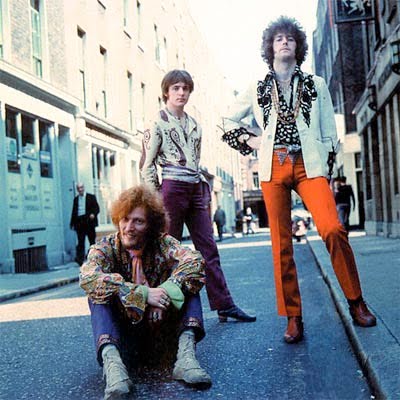 Clapton left the Bluesbreakers in July 1966 (replaced by Peter Green) and was invited by drummer Ginger Baker to play in his newly formed band Cream, one of the earliest supergroups, with Jack Bruce on bass (Bruce was previously of the Bluesbreakers, the Graham Bond Organisation and Manfred Mann). Before the formation of Cream, Clapton was not well known in the United States; he left the Yardbirds before “For Your Love” hit the U.S. Top Ten, and had yet to perform there. During his time with Cream, Clapton began to develop as a singer, songwriter, and guitarist, though Bruce took most of the lead vocals and wrote the majority of the material with lyricist Pete Brown. Cream’s first gig was an unofficial performance at the Twisted Wheel Club in Manchester on 29 July 1966 before their full debut two nights later at the National Jazz and Blues Festival in Windsor. Cream established its enduring legend with the high-volume blues jamming and extended solos of their live shows.
Clapton left the Bluesbreakers in July 1966 (replaced by Peter Green) and was invited by drummer Ginger Baker to play in his newly formed band Cream, one of the earliest supergroups, with Jack Bruce on bass (Bruce was previously of the Bluesbreakers, the Graham Bond Organisation and Manfred Mann). Before the formation of Cream, Clapton was not well known in the United States; he left the Yardbirds before “For Your Love” hit the U.S. Top Ten, and had yet to perform there. During his time with Cream, Clapton began to develop as a singer, songwriter, and guitarist, though Bruce took most of the lead vocals and wrote the majority of the material with lyricist Pete Brown. Cream’s first gig was an unofficial performance at the Twisted Wheel Club in Manchester on 29 July 1966 before their full debut two nights later at the National Jazz and Blues Festival in Windsor. Cream established its enduring legend with the high-volume blues jamming and extended solos of their live shows.
By early 1967, fans of the emerging blues-rock sound in Britain had begun to portray Clapton as Britain’s top guitarist; however, he found himself rivalled by the emergence of Jimi Hendrix, an acid rock-infused guitarist who used wailing feedback and effects pedals to create new sounds for the instrument. Hendrix attended a performance of the newly formed Cream at the Central London Polytechnic on 1 October 1966, during which he sat in on a double-timed version of “Killing Floor”. Top UK stars, including Clapton, Pete Townshend, members of the Rolling Stones, and the Beatles, avidly attended Hendrix’s early club performances. Hendrix’s arrival had an immediate and major effect on the next phase of Clapton’s career.
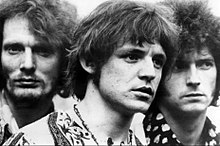 Clapton first visited the United States while touring with Cream. In March 1967, Cream performed a nine-show stand at the RKO Theater in New York. They recorded Disraeli Gears in New York from 11 to 15 May 1967. Cream’s repertoire varied from hard rock (“I Feel Free”) to lengthy blues-based instrumental jams (“Spoonful”). Disraeli Gears featured Clapton’s searing guitar lines, Bruce’s soaring vocals and prominent, fluid bass playing, and Baker’s powerful, polyrhythmic jazz-influenced drumming. Together, Cream’s talents secured them as an influential power trio.
Clapton first visited the United States while touring with Cream. In March 1967, Cream performed a nine-show stand at the RKO Theater in New York. They recorded Disraeli Gears in New York from 11 to 15 May 1967. Cream’s repertoire varied from hard rock (“I Feel Free”) to lengthy blues-based instrumental jams (“Spoonful”). Disraeli Gears featured Clapton’s searing guitar lines, Bruce’s soaring vocals and prominent, fluid bass playing, and Baker’s powerful, polyrhythmic jazz-influenced drumming. Together, Cream’s talents secured them as an influential power trio.
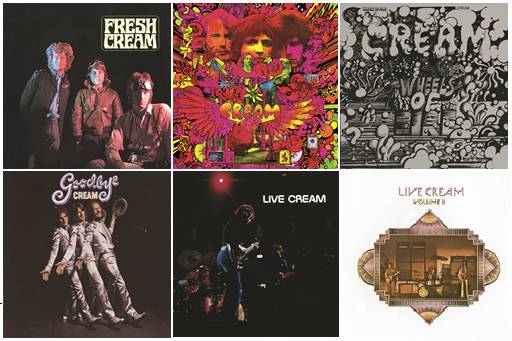
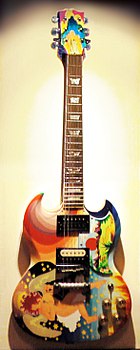
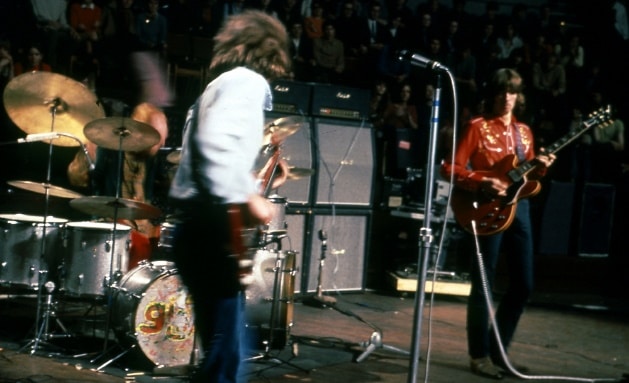
In 28 months, Cream had become a commercial success, selling millions of records and playing throughout the U.S. and Europe. They redefined the instrumentalist’s role in rock and were one of the first blues-rock bands to emphasize musical virtuosity and lengthy jazz-style improvisation sessions. Their US hit singles include “Sunshine of Your Love” (No. 5, 1968), “White Room” (No. 6, 1968) and “Crossroads” (No. 28, 1969) – a live version of Robert Johnson’s “Cross Road Blues”. Though Cream was hailed as one of the greatest groups of its day, and the adulation of Clapton as a guitar legend reached new heights, the supergroup was short-lived. Drug and alcohol use escalated tension between the three members, and conflicts between Bruce and Baker eventually led to Cream’s demise. A strongly critical Rolling Stone review of a concert of the group’s second headlining U.S. tour was another significant factor in the trio’s demise, and it affected Clapton. 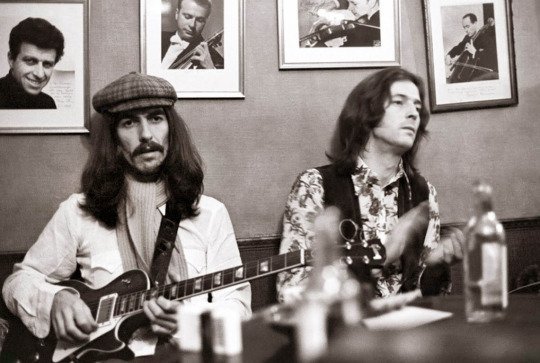
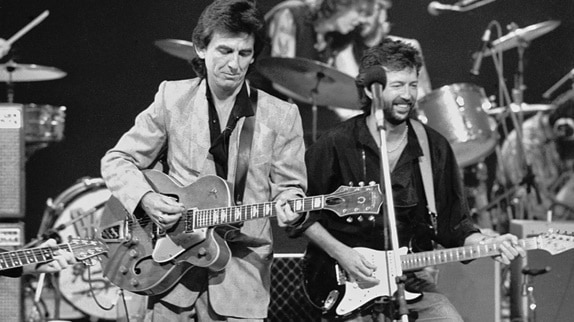
Cream’s farewell album, Goodbye, featuring live performances recorded at The Forum, Los Angeles, 19 October 1968, was released shortly after Cream disbanded; it also featured the studio single “Badge”, co-written by Clapton and George Harrison. Clapton met Harrison and became close friends with him after the Beatles shared a bill with the Clapton-era Yardbirds at the London Palladium. Clapton played the lead guitar solo on Harrison’s “While My Guitar Gently Weeps” from the Beatles’ White Album (1968). Harrison’s debut solo album, Wonderwall Music, in 1968, became the first of many Harrison solo records to include Clapton on guitar. Clapton would go largely uncredited for his contributions to Harrison’s albums due to contractual restraints, and Harrison was credited as “L’Angelo Misterioso” for his contributions to the song “Badge” on Goodbye. The pair would often play live together as each other’s guest. A year after Harrison’s death in 2001, Clapton was musical director for the Concert for George.
Blind Faith, Delaney and Bonnie and Friends
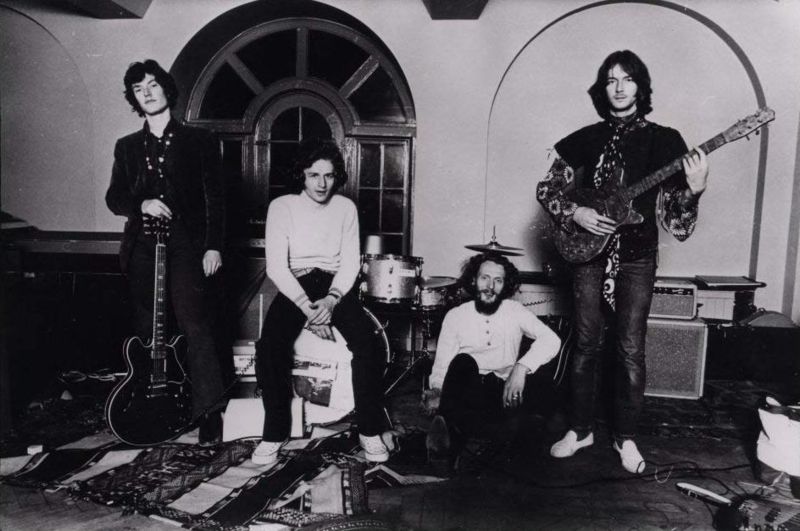
Clapton’s next group, Blind Faith (1969), was composed of Cream drummer Ginger Baker, Steve Winwood of Traffic, and Ric Grech of Family, and yielded one LP and one arena-circuit tour. The supergroup debuted before 100,000 fans in London’s Hyde Park on 7 June 1969. They performed several dates in Scandinavia and began a sold-out American tour in July before their only album was released. The LP Blind Faith consisted of just six songs, one of them the hit “Can’t Find My Way Home”. The album’s jacket image of a topless pubescent girl was deemed controversial in the US and was replaced by a photograph of the band. Blind Faith dissolved after less than seven months.
Clapton subsequently toured as a sideman for an act that had opened for Blind Faith, Delaney and Bonnie and Friends. He also played two dates as a member of the Plastic Ono Band that autumn, including a recorded performance at the Toronto Rock and Roll Revival in September 1969 released as the album Live Peace in Toronto 1969. On 30 September 1969, Clapton played lead guitar on Lennon’s second solo single, “Cold Turkey”. On 15 December 1969 Clapton performed with Lennon, George Harrison, and others as the Plastic Ono Band at a fundraiser for UNICEF in London.
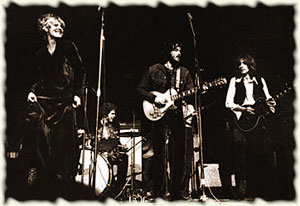 Delaney Bramlett encouraged Clapton in his singing and writing. Using the Bramletts’ backing group and an all-star cast of session players (including Leon Russell and Stephen Stills), Clapton recorded his first solo album during two brief tour hiatuses, titled Eric Clapton. Delaney Bramlett co-wrote six of the songs with Clapton, also producing the LP, and Bonnie Bramlett co-wrote “Let It Rain”. The album yielded the unexpected US No. 18 hit, J. J. Cale’s “After Midnight”. Clapton also worked with much of Delaney and Bonnie’s band to record George Harrison’s All Things Must Pass in spring 1970.
Delaney Bramlett encouraged Clapton in his singing and writing. Using the Bramletts’ backing group and an all-star cast of session players (including Leon Russell and Stephen Stills), Clapton recorded his first solo album during two brief tour hiatuses, titled Eric Clapton. Delaney Bramlett co-wrote six of the songs with Clapton, also producing the LP, and Bonnie Bramlett co-wrote “Let It Rain”. The album yielded the unexpected US No. 18 hit, J. J. Cale’s “After Midnight”. Clapton also worked with much of Delaney and Bonnie’s band to record George Harrison’s All Things Must Pass in spring 1970.
During this busy season, Clapton also recorded with other artists including Dr. John, Leon Russell, Plastic Ono Band, Billy Preston, Ringo Starr and Dave Mason. With Chicago blues artist Howlin’ Wolf, he recorded The London Howlin’ Wolf Sessions, that also included long-time Wolf guitarist Hubert Sumlin and members of the Rolling Stones, Winwood, Starr, and others. Despite the superstar line up, critic Cub Koda noted: “Even Eric Clapton, who usually welcomes any chance to play with one of his idols, has criticized this album repeatedly in interviews, which speaks volumes in and of itself.”
Other noted recordings from this period include Clapton’s guitar work on “Go Back Home” from Stephen Stills’ self-titled first solo album.
“Layla” and solo career

The band was originally called “Eric Clapton and Friends”. The name “Derek and the Dominos” was a fluke that occurred when the band’s provisional name of “Del and the Dynamos” was misread as Derek and the Dominos. Clapton’s biography states that Tony Ashton of Ashton, Gardner and Dyke told Clapton to call the band “Del and the Dominos”, since “Del” was his nickname for Eric Clapton. Del and Eric were combined and the final name became “Derek and the Dominos”.
Clapton’s close friendship with George Harrison brought him into contact with Harrison’s wife, Pattie Boyd, with whom he became deeply infatuated. When she spurned his advances, Clapton’s unrequited affections prompted most of the material for the Dominos’ album, Layla and Other Assorted Love Songs (1970). Heavily blues-influenced, the album features the twin lead guitars of Clapton and Duane Allman, with Allman’s slide guitar as a key ingredient of the sound. Working at Criteria Studios in Miami with Atlantic Records producer Tom Dowd, who had worked with Clapton on Cream’s Disraeli Gears, the band recorded a double album.
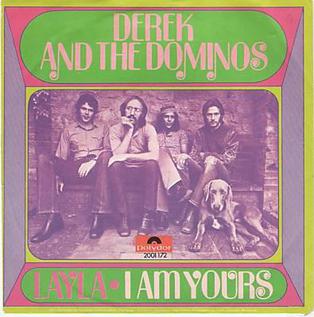 The album features the hit love song “Layla”, inspired by the classical poet of Persian literature, Nizami Ganjavi’s The Story of Layla and Majnun, a copy of which Ian Dallas had given to Clapton. The book moved Clapton profoundly, as it was the tale of a young man who fell hopelessly in love with a beautiful, unavailable woman and who went crazy because he could not marry her. The two parts of “Layla” were recorded in separate sessions: the opening guitar section was recorded first, and for the second section, laid down a few weeks later, drummer Jim Gordon played the piano part for the melody which he claimed to have written (though Bobby Whitlock stated that Rita Coolidge wrote it).
The album features the hit love song “Layla”, inspired by the classical poet of Persian literature, Nizami Ganjavi’s The Story of Layla and Majnun, a copy of which Ian Dallas had given to Clapton. The book moved Clapton profoundly, as it was the tale of a young man who fell hopelessly in love with a beautiful, unavailable woman and who went crazy because he could not marry her. The two parts of “Layla” were recorded in separate sessions: the opening guitar section was recorded first, and for the second section, laid down a few weeks later, drummer Jim Gordon played the piano part for the melody which he claimed to have written (though Bobby Whitlock stated that Rita Coolidge wrote it).
The Layla LP was actually recorded by a five-piece version of the group, thanks to the unforeseen inclusion of guitarist Duane Allman of the Allman Brothers Band. A few days into the Layla sessions, Dowd—who was also producing the Allmans—invited Clapton to an Allman Brothers outdoor concert in Miami. The two guitarists met first on stage, then played all night in the studio, and became friends. Duane first added his slide guitar to “Tell the Truth” and “Nobody Knows You When You’re Down and Out”. In four days, the five-piece Dominos recorded “Key to the Highway”, “Have You Ever Loved a Woman” (a blues standard popularized by Freddie King and others), and “Why Does Love Got to be So Sad”. In September, Duane briefly left the sessions for gigs with his own band, and the four-piece Dominos recorded “I Looked Away”, “Bell Bottom Blues”, and “Keep on Growing”. Duane returned to record “I am Yours”, “Anyday”, and “It’s Too Late”. On 9 September, they recorded Hendrix’s “Little Wing” and the title track. The following day, the final track, “It’s Too Late”, was recorded.
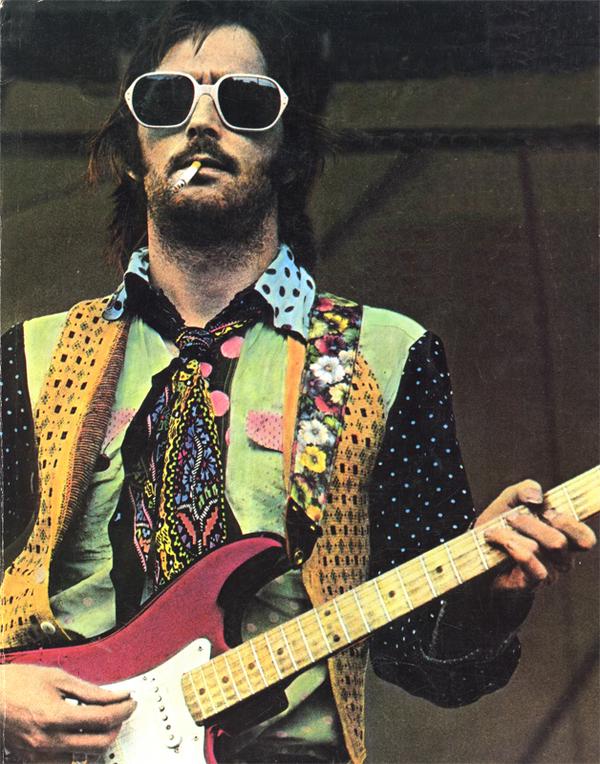
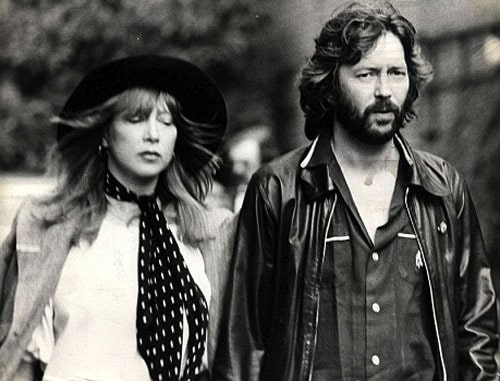
Personal problems and early solo success
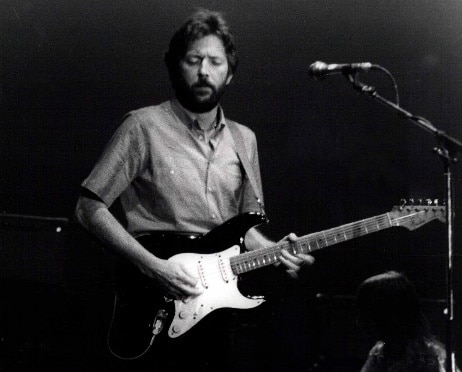
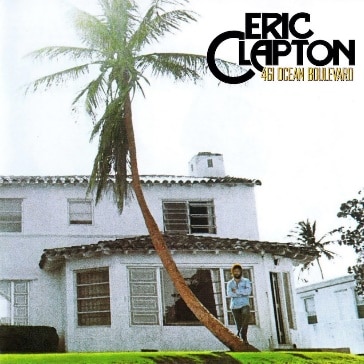 Clapton’s career successes in the 1970s were in stark contrast with the struggles he coped with in his personal life, which was troubled by romantic longings and drug and alcohol addiction. He became infatuated with Pattie Boyd, who at the time was married to close friend George Harrison, and withdrew from recording and touring to isolation in his Surrey residence as the band broke up.
Clapton’s career successes in the 1970s were in stark contrast with the struggles he coped with in his personal life, which was troubled by romantic longings and drug and alcohol addiction. He became infatuated with Pattie Boyd, who at the time was married to close friend George Harrison, and withdrew from recording and touring to isolation in his Surrey residence as the band broke up.
There he nursed a heroin addiction, which resulted in a lengthy career hiatus interrupted only by the Concert for Bangladesh in August 1971 (where he passed out on stage, was revived, and managed to finish his performance).
In January 1973, the Who’s Pete Townshend organized a comeback concert for Clapton at London’s Rainbow Theatre, aptly titled the “Rainbow Concert”, to help Clapton kick his addiction. Clapton returned the favor by playing “The Preacher” in Ken Russell’s film version of the Who’s Tommy in 1975; his appearance in the film (performing “Eyesight to the Blind”) is notable as he is clearly wearing a fake beard in some shots, the result of deciding to shave off his real beard after the initial takes in an attempt to force the director to remove his earlier scene from the movie and leave the set.
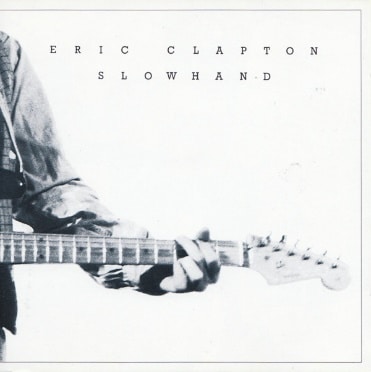 In 1974, Clapton started living with Pattie Boyd (they would not marry until 1979) and was no longer using heroin (although he began to drink heavily). He assembled a low-key touring band that included Radle, Miami guitarist George Terry, keyboardist Dick Sims (who died in 2011drummer Jamie Oldaker, and vocalists Yvonne Elliman and Marcy Levy (also known as Marcella Detroit). With this band Clapton recorded 461 Ocean Boulevard (1974), an album with an emphasis on more compact songs and fewer guitar solos; the cover version of “I Shot the Sheriff” was Clapton’s first number one hit and was important in bringing reggae and the music of Bob Marley to a wider audience. The 1975 album There’s One in Every Crowd continued this trend. The album’s original title, The World’s Greatest Guitar Player (There’s One in Every Crowd), was changed before pressing, as it was felt its ironic intention would be misunderstood. The band toured the world and subsequently released the 1975 live LP, E. C. Was Here. Clapton continued to release albums and toured regularly. Highlights of the period include No Reason to Cry (a collaboration with Bob Dylan and The Band); Slowhand, which featured “Wonderful Tonight” and a second J. J. Cale cover, “Cocaine”. In 1976 he performed as one of a string of notable guests at the farewell performance of The Band, filmed in a Martin Scorsese documentary called The Last Waltz.
In 1974, Clapton started living with Pattie Boyd (they would not marry until 1979) and was no longer using heroin (although he began to drink heavily). He assembled a low-key touring band that included Radle, Miami guitarist George Terry, keyboardist Dick Sims (who died in 2011drummer Jamie Oldaker, and vocalists Yvonne Elliman and Marcy Levy (also known as Marcella Detroit). With this band Clapton recorded 461 Ocean Boulevard (1974), an album with an emphasis on more compact songs and fewer guitar solos; the cover version of “I Shot the Sheriff” was Clapton’s first number one hit and was important in bringing reggae and the music of Bob Marley to a wider audience. The 1975 album There’s One in Every Crowd continued this trend. The album’s original title, The World’s Greatest Guitar Player (There’s One in Every Crowd), was changed before pressing, as it was felt its ironic intention would be misunderstood. The band toured the world and subsequently released the 1975 live LP, E. C. Was Here. Clapton continued to release albums and toured regularly. Highlights of the period include No Reason to Cry (a collaboration with Bob Dylan and The Band); Slowhand, which featured “Wonderful Tonight” and a second J. J. Cale cover, “Cocaine”. In 1976 he performed as one of a string of notable guests at the farewell performance of The Band, filmed in a Martin Scorsese documentary called The Last Waltz.
Tragedy, healing and resurgence
The 1990s brought a series of 32 concerts to the Royal Albert Hall, such as the 24 Nights series of concerts that took place around January through February 1990, and February to March 1991. On 27 August 1990, fellow blues guitarist Stevie Ray Vaughan, who was touring with Clapton, and three members of their road crew were killed in a helicopter crash between concerts. Then, on 20 March 1991, Clapton’s four-year-old son, Conor, died after falling from the 53rd-floor window of his mother’s friend’s New York City apartment at 117 East 57th Street. Conor’s funeral took place on 28 March at St Mary Magdalene’s Church in Clapton’s home village in Ripley, Surrey.
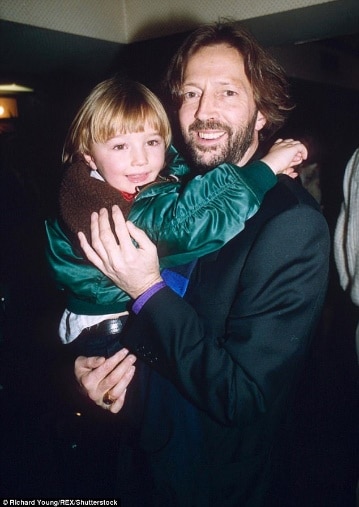 Clapton’s grief was expressed in the song “Tears in Heaven”, which was co-written by Will Jennings. At the 35th Annual Grammy Awards, Clapton received six Grammys for the single “Tears in Heaven” and his Unplugged album. Unplugged features Clapton performing live in front of a small audience on 16 January 1992 at Bray Film Studios in Windsor, Berkshire, England.
Clapton’s grief was expressed in the song “Tears in Heaven”, which was co-written by Will Jennings. At the 35th Annual Grammy Awards, Clapton received six Grammys for the single “Tears in Heaven” and his Unplugged album. Unplugged features Clapton performing live in front of a small audience on 16 January 1992 at Bray Film Studios in Windsor, Berkshire, England.
The album reached number one on the Billboard 200, and is certified Diamond by the RIAA for selling over 10 million copies in the US. It reached number two in the UK Albums Chart and is certified four times platinum in the UK.
On 9 September 1992, Clapton performed “Tears in Heaven” at the 1992 MTV Video Music Awards, and won the award for Best Male Video.
In 1992 he received the Ivor Novello Award for Lifetime Achievement from the British Academy of Songwriters, Composers and Authors.
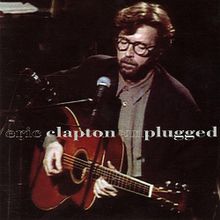 In October 1992 Clapton was among the dozens of artists performing at Bob Dylan’s 30th Anniversary Concert Celebration. Recorded at Madison Square Garden in New York City, the live two-disk CD/DVD captured a show full of celebrities performing classic Dylan songs, with Clapton playing the lead on a nearly 7-minute version of Dylan’s “Knockin’ on Heaven’s Door” as part of the finale. While Unplugged featured Clapton playing acoustic guitar, his 1994 album From the Cradle contained new versions of old blues standards, highlighted by his electric guitar playing. In 1995, Clapton for the first and only time featured on a UK No. 1 single, collaborating with Chrissie Hynde, Cher and Neneh Cherry on a solo to a cover of “Love Can Build a Bridge” released in aid of the British charity telethon Comic Relief.
In October 1992 Clapton was among the dozens of artists performing at Bob Dylan’s 30th Anniversary Concert Celebration. Recorded at Madison Square Garden in New York City, the live two-disk CD/DVD captured a show full of celebrities performing classic Dylan songs, with Clapton playing the lead on a nearly 7-minute version of Dylan’s “Knockin’ on Heaven’s Door” as part of the finale. While Unplugged featured Clapton playing acoustic guitar, his 1994 album From the Cradle contained new versions of old blues standards, highlighted by his electric guitar playing. In 1995, Clapton for the first and only time featured on a UK No. 1 single, collaborating with Chrissie Hynde, Cher and Neneh Cherry on a solo to a cover of “Love Can Build a Bridge” released in aid of the British charity telethon Comic Relief.
Clapton’s 1996 recording of the Wayne Kirkpatrick/Gordon Kennedy/Tommy Sims tune “Change the World” (featured in the soundtrack of the film Phenomenon) won the Grammy Award for Song of the Year in 1997, the same year he recorded Retail Therapy (an album of electronic music with Simon Climie under the pseudonym TDF). On 15 September 1997, Clapton appeared at the Music for Montserrat concert at the Royal Albert Hall, London, performing “Layla” and “Same Old Blues” before finishing with “Hey Jude” alongside fellow English artists Paul McCartney, Elton John, Phil Collins, Mark Knopfler and Sting. That autumn, Clapton released the album Pilgrim, the first record featuring new material for almost a decade.
In 1996 Clapton had a relationship with singer-songwriter Sheryl Crow. They remain friends, and Clapton appeared as a guest on Crow’s Central Park Concert. The duo performed a Cream hit single, “White Room”. Later, Clapton and Crow performed an alternate version of “Tulsa Time” with other guitar legends at the Crossroads Guitar Festival in June 2007 as well as Robert Johnson’s blues classic “Crossroads” at London’s Hyde Park in August 2008 with John Mayer and Robert Randolph.
In 1998 Clapton, then 53, met 22-year-old administrative assistant Melia McEnery in Columbus, Ohio, at a party given for him after a performance. He quietly dated her for a year, and went public with the relationship in 1999. They married on 1 January 2001 at St Mary Magdalene church in Clapton’s birthplace, Ripley. They have three daughters, Julie Rose (13 June 2001), Ella May (14 January 2003), and Sophie Belle (1 February 2005).
At the 41st Annual Grammy Awards on 24 February 1999, Clapton received his third Grammy Award for Best Male Pop Vocal Performance, for his song “My Father’s Eyes”. In October 1999, the compilation album, Clapton Chronicles: The Best of Eric Clapton, was released, which contained a new song, “Blue Eyes Blue”, that also appears in soundtrack for the film, Runaway Bride. Clapton finished the twentieth century with collaborations with Carlos Santana and B.B. King.
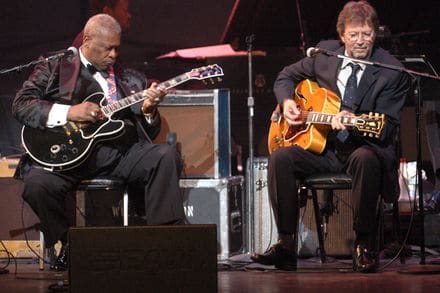
Influences
Clapton cites Muddy Waters, Freddie King, B.B. King, Albert King, Buddy Guy, and Hubert Sumlin as guitar playing influences. Clapton stated blues musician Robert Johnson to be his single most important influence. In 2004 Clapton released CDs and DVDs entitled Sessions for Robert Johnson, featuring covers of Robert Johnson songs using electric and acoustic guitars.
Legacy
Clapton has been referred to as one of the most important and influential guitarists of all time. Clapton is the only three-time inductee to the Rock and Roll Hall of Fame: once as a solo artist, and separately as a member of the Yardbirds and Cream. He ranked second in Rolling Stone magazine’s list of the “100 Greatest Guitarists of All Time” and fourth in Gibson’s Top 50 Guitarists of All Time.
Guitars
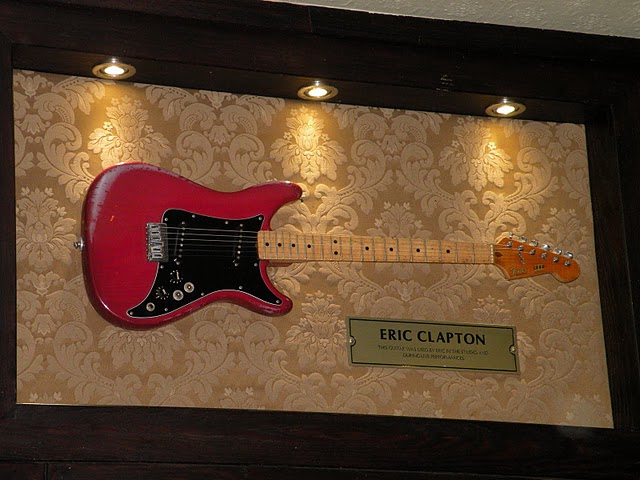
Clapton’s choice of electric guitars has been as notable as the man himself; like Hank Marvin, the Beatles and Jimi Hendrix, Clapton exerted a crucial and widespread influence in popularizing particular models of electric guitar. With the Yardbirds, Clapton played a Fender Telecaster, a Fender Jazzmaster, a double-cutaway Gretsch 6120, and a 1964 Cherry-Red Gibson ES-335. He became exclusively a Gibson player for a period beginning in mid-1965, when he purchased a used sunburst Gibson Les Paul guitar from a guitar store in London. Clapton commented on the slim profile of the neck, which would indicate it was a 1960 model.
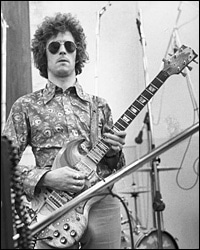 Early during his stint in Cream, Clapton’s first Les Paul Standard was stolen. He continued to play Les Pauls exclusively with Cream until 1967, when he acquired his most famous guitar in this period, a 1964 Gibson SG, dubbed “the Fool”. Clapton used both the Les Paul and the SG to create his self-described “woman tone”. He explained in a 1967 interview, “I am playing more smoothly now. I’m developing what I call my ‘woman tone.’ It’s a sweet sound, something like the solo on ‘I Feel Free’.” Writer Michael Dregni describes it as “thick yet piercing, overdriven yet smooth, distorted yet creamy”. The tone is achieved by a combination of tone control settings on the guitars and Clapton’s Marshall JTM45 amplifier. Vintage Guitar magazine identifies “the opening riff and solo of ‘Sunshine of Your Love’ are arguably the best illustrations of full-blown woman tone”. Clapton’s “Fool” acquired its name from its distinctive psychedelic paint job, created by the visual art collective also known as the Fool (just before Cream’s first US appearance in 1967, Clapton’s SG, Bruce’s Fender VI, and Baker’s drum head were all repainted in psychedelic designs).
Early during his stint in Cream, Clapton’s first Les Paul Standard was stolen. He continued to play Les Pauls exclusively with Cream until 1967, when he acquired his most famous guitar in this period, a 1964 Gibson SG, dubbed “the Fool”. Clapton used both the Les Paul and the SG to create his self-described “woman tone”. He explained in a 1967 interview, “I am playing more smoothly now. I’m developing what I call my ‘woman tone.’ It’s a sweet sound, something like the solo on ‘I Feel Free’.” Writer Michael Dregni describes it as “thick yet piercing, overdriven yet smooth, distorted yet creamy”. The tone is achieved by a combination of tone control settings on the guitars and Clapton’s Marshall JTM45 amplifier. Vintage Guitar magazine identifies “the opening riff and solo of ‘Sunshine of Your Love’ are arguably the best illustrations of full-blown woman tone”. Clapton’s “Fool” acquired its name from its distinctive psychedelic paint job, created by the visual art collective also known as the Fool (just before Cream’s first US appearance in 1967, Clapton’s SG, Bruce’s Fender VI, and Baker’s drum head were all repainted in psychedelic designs).
In 1968 Clapton bought a Gibson Firebird and started using the 1964 Cherry-Red Gibson ES-335 again. The aforementioned 1964 ES-335 had a storied career. Clapton used it at the last Cream show in November 1968 as well as with Blind Faith, played it sparingly for slide pieces in the 1970s, used it on “Hard Times” from Journeyman, the Hyde Park live concert of 1996, and the From the Cradle sessions and tour of 1994–95. It was sold for US$847,500 at a 2004 auction. Gibson produced a limited run of 250 “Crossroads 335” replicas. The 335 was only the second electric guitar Clapton bought. 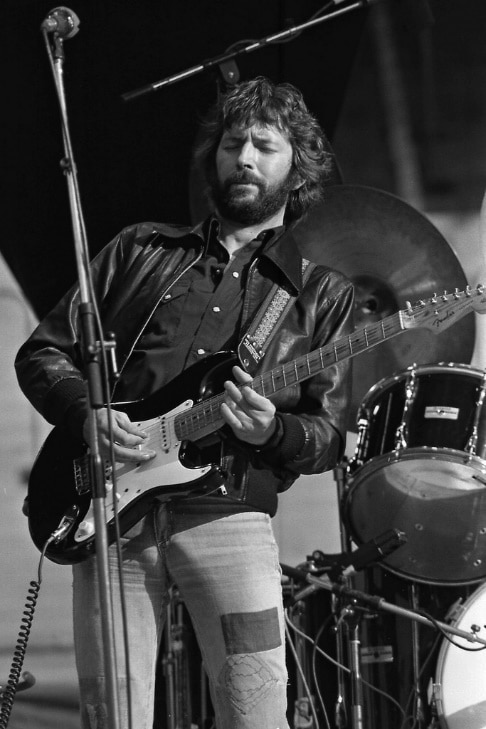
In July 1968 Clapton gave George Harrison a 1957 ‘goldtop’ Gibson Les Paul that been refinished with a red colour, nicknamed Lucy. The following September, Clapton played the guitar on the Beatles’ recording of “While My Guitar Gently Weeps”. Lucy was stolen from Harrison, though later tracked down and returned to him – he lent it to Clapton for his 1973 comeback concert at the Rainbow. His SG “The Fool” found its way into the hands of George Harrison’s friend Jackie Lomax, who subsequently sold it to musician Todd Rundgren for US$500 in 1972. Rundgren restored the guitar and nicknamed it “Sunny”, after “Sunshine of Your Love”. He retained it until 2000, when he sold it at an auction for US$150,000. At the 1969 Blind Faith concert in Hyde Park, London Clapton played a Fender Custom Telecaster, which was fitted with “Brownie’s neck.
In late 1969 Clapton made the switch to the Fender Stratocaster. The first—used during the recording of Eric Clapton—was “Brownie”, which in 1973 became the backup to the most famous of all Clapton’s guitars, “Blackie”. In November 1970 Eric bought six Fender Stratocasters from the Sho-bud guitar shop in Nashville, Tennessee while on tour with the Dominos. He gave one each to George Harrison, Steve Winwood, and Pete Townshend.
Clapton assembled the best components of the remaining three to create “Blackie”, which was his favorite stage guitar until its retirement in 1985. It was first played live 13 January 1973 at the Rainbow Concert. Clapton called the 1956/57 Strat a “mongrel”. On 24 June 2004, Clapton sold “Blackie” at Christie’s Auction House, New York, for US$959,500 to raise funds for his Crossroads Centre for drug and alcohol addictions. “Brownie” is now on display at the Experience Music Project. The Fender Custom Shop has since produced a limited run of 275 ‘Blackie’ replicas, correct in every detail right down to the ‘Duck Brothers’ flight case, and artificially aged using Fender’s ‘Relic’ process to simulate years of hard wear. One was presented to Clapton upon the model’s release and was used for three numbers during a concert at the Royal Albert Hall on 17 May 2006. In 1979 Clapton gave his signed Fender Lead II guitar to the Hard Rock Cafe in London to designate his favorite bar stool. Pete Townshend also donated his own Gibson Les Paul guitar, with a note attached: “Mine’s as good as his! Love, Pete”.
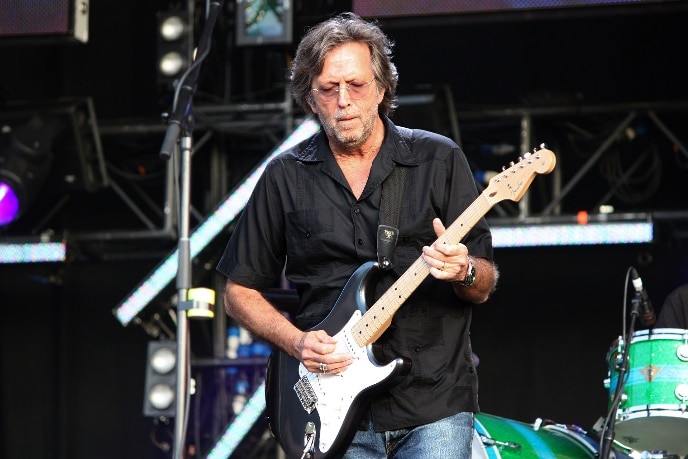
Signature guitars in Clapton’s honor are made by Fender and C.F. Martin & Company. In 1988 Fender introduction his signature Eric Clapton Stratocaster. Several signature-model 000-sized acoustic guitars made by Martin. The first, of these, introduced in 1995, was a limited edition 000-42EC Eric Clapton signature model with a production run of 461. For the single “Change the World” (1996) and the album Pilgrim (1998) he used a Martin 000-28 EC Eric Clapton signature model, which he subsequently gave to guitarist Paul Wassif. His 1939 000-42 Martin that he played on the Unplugged album sold for US$791,500 at auction.
In 1999, Clapton auctioned off some of his guitar collection to raise more than US$5 million for continuing support of the Crossroads Centre in Antigua, which he founded in 1997. In 2004 Clapton organized and participated in the Crossroads Guitar Festival to benefit the centre. A second guitar auction, including the “Cream” of Clapton’s collection – as well as guitars donated by famous friends – was held on 24 June 2004. His Lowden acoustic guitar sold for US$41,825. The revenue garnered by this auction at Christie’s was US$7,438,624.
In 2010 Eric Clapton announced that he would be auctioning off over 150 items at a New York auction in 2011 with proceeds to go to his Crossroads Centre drug and rehabilitation centre in Antigua. Items included Clapton’s guitar from the Cream reunion tour in 2005, speaker cabinets used in the early 1970s from his days with Derek and the Dominos, and some guitars from Jeff Beck, J. J. Cale, and Joe Bonamassa. In March 2011 Clapton raised more than US$2.15 million when he auctioned off key items, including a 1984 Gibson hollow body guitar, a Gianni Versace suit from his 1990 concert at the Royal Albert Hall, and a replica of the famous Fender Stratocaster known as “Blackie”, which fetched more than $30,000. All proceeds again went to Crossroads. Clapton uses Ernie Ball Slinky and Super Slinky strings, gauge .10 to.46. His guitar technician for over thirty years was Lee Dickson
